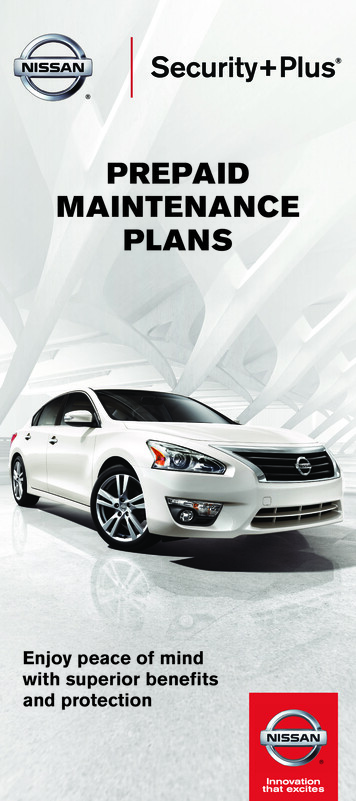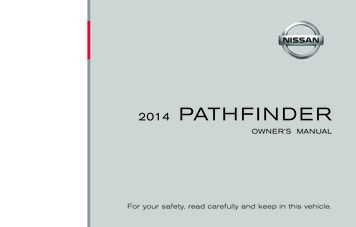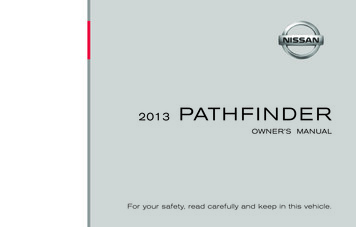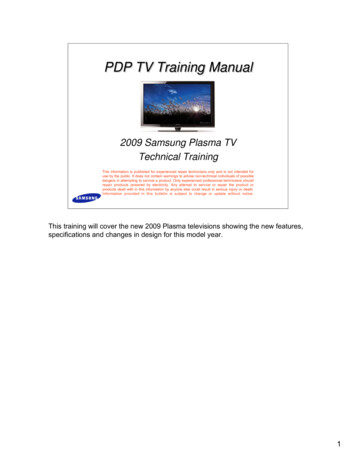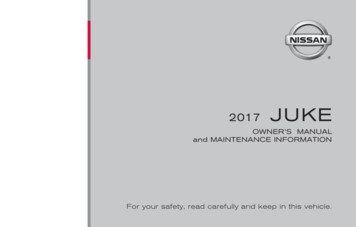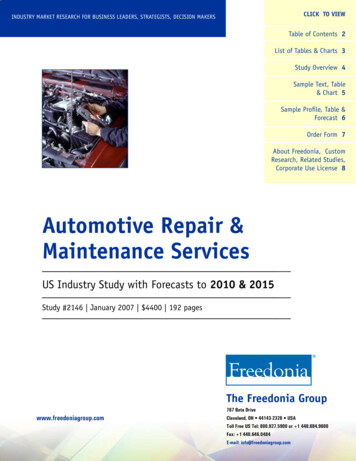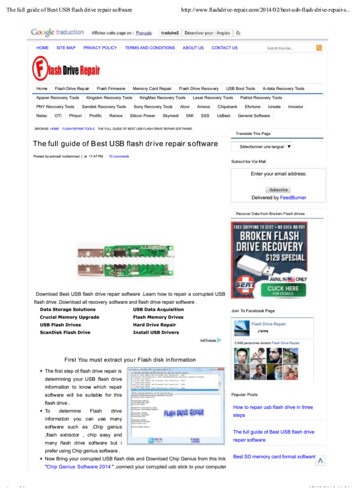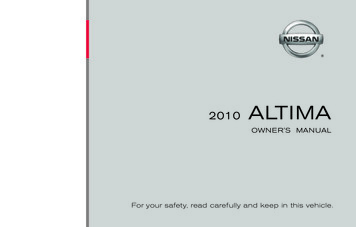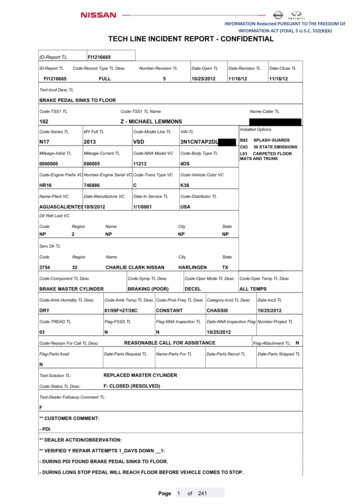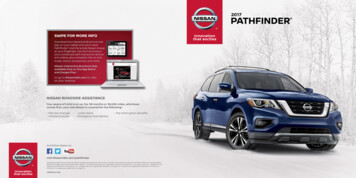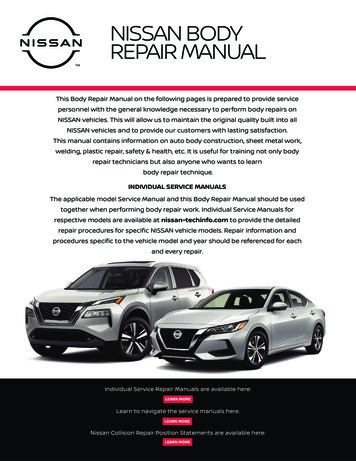
Transcription
NISSAN BODYREPAIR MANUALThis Body Repair Manual on the following pages is prepared to provide servicepersonnel with the general knowledge necessary to perform body repairs onNISSAN vehicles. This will allow us to maintain the original quality built into allNISSAN vehicles and to provide our customers with lasting satisfaction.This manual contains information on auto body construction, sheet metal work,welding, plastic repair, safety & health, etc. It is useful for training not only bodyrepair technicians but also anyone who wants to learnbody repair technique.INDIVIDUAL SERVICE MANUALSThe applicable model Service Manual and this Body Repair Manual should be usedtogether when performing body repair work. Individual Service Manuals forrespective models are available at nissan-techinfo.com to provide the detailedrepair procedures for specific NISSAN vehicle models. Repair information andprocedures specific to the vehicle model and year should be referenced for eachand every repair.Individual Service Repair Manuals are available here:LEARN MORELearn to navigate the service manuals here:LEARN MORENissan Collision Repair Position Statements are available here:LEARN MORE
BODY EXTERIOR, DOORS, ROOF & VEHICLE SECURITYSECTIONBRMBODY REPAIRABCDCONTENTSFUNDAMENTALSEKingpin Angle .41Toe .41Non-standard Conditions Caused by ImproperWheel Alignment .42FForeword . 5BODY MATERIALS . 43GAUTO BODY CONSTRUCTION . 6SHEET STEEL .43Properties of Sheet Steel .43Thermal Effects on Steel .45Types of Sheet Steel .46HSERVICE INFORMATION . 5FOREWORD . 5BODY TYPES AND STRUCTURE . 6Body Types and Structure . 6Frame Body . 6Uni-body . 6Requirements for Passenger Car Body . 17To Increase Vehicle Rigidity and Strength . 18To Reduce Noise and Vibration . 20COLLISION DYNAMICS . 20Collision Dynamics . 20Five Elements of Force . 20Direction of Impact Force . 21Impact Force and Collision Area . 22Concentration of Stress . 22Propagation of Impact Force . 23Direct Damage and Indirect Damage . 23Features of Impact Applied to Each Portion ofBody . 23BODY ALIGNMENT . 25Body Alignment . 25Engine Compartment . 25Underbody . 27Passenger Compartment and Rear Body . 31Body Center Marks (Example) . 35Measurement Mark Types . 36SUSPENSION TYPES . 37Suspension Types . 37Front Suspension . 37Rear Suspension . 39WHEEL ALIGNMENT . 41Wheel Alignment . 41Camber Angle . 41Caster Angle . 41ALUMINUM .48Aluminum .48Lightweight .48Corrosion Resistance .48Excellent Heat Conductor .48Excellent Electrical Conductor .48Anti-magnetic .48Recyclable .48Structure of Aluminum Alloy (Used for VehicleBody Parts) .48TYPES OF PLASTIC .49Classification of Plastic .49Characteristics .50Location of Plastic Parts (Example) .51Handling Precautions for Plastics (Example) .52RUST PREVENTION .53Rust Prevention .53Anti-corrosive Wax .53Sealing .54Spot Sealer, Weld Through Primer and AdhesiveSealer .57Undercoating and Stone Guard Coat .57SHEET METAL WORK . 59SHEET METAL WORK TOOLS .59Sheet Metal Work Tools .59Hammers .59Dollies .62How to Use Hammer and Dolly .65Spoons .68BRM-1IJBRMLMNOP
Scribing Chisels . 70Types and Uses of Tinman's Shears . 72Tools for Pulling . 73SHRINKING THE SHEET METAL . 78Shrinking The Sheet Metal . 78Shrinking Methods . 78How to Heat Sheet Metal . 80CORRECTING A DEFORMED PANEL . 82Determining Panel Damage . 82Basic Types of Damage . 83Examination of Panel Damage . 83Elastic VS. Plastic Deformation . 85Basic Repair Procedure . 86COLORED SHEET METAL WORK . 90Colored Sheet Metal Work . 90Confirmation of The Panel . 90Selection of Repair Tools . 91Panel Repair Methods . 92Polishing of Panel Surface and Anti-corrosiveTreatment . 94Examination of Panel . 94BODY WELDING AND PRECAUTIONS . 95OUTLINE OF WELDING . 95Outline of Welding . 95Types of Welding . 95Features of Welding . 96Welding of Automovile Body . 96ELECTRIC RESISTANCE SPOT WELDING . 97Principles of Spot Welding . 97Features of Spot Welding . 97Construction of Spot Welder . 97Cooling Methods . 98Spot Welding Gun . 98Mult-functional Type Spot Welder . 99Process of Spot Welding .100Element of Spot Welding .101Current Pulse Shape .102Condition of the Panel .103Precautions when Performing Spot Welding .104Inspection of Welded Portion .107ARC WELDING .109Arc Welding .109Principles of MIG and MAG Arc Welding .109Features of MIG and MAG Welding .109Structure of MIG and MAG Welding Machine .110Condition of Panel to be Welded .110Inspection of Welded Portions .111Types of MIG and MAG Welding .112GAS WELDING .114Gas Welding .114Features of Gas Welding Method .114Configuration of Gas Welding Equipment .114Welding Torch .115Cutting Torch . 115Flame Types . 116BRAZING . 117Principle . 117Features of Brazing . 117Types of Brazing Filler . 117COMPARISON BETWEEN WELDING METHODSFOR REPLACED PANEL . 118Comparison between Welding Methods for Replaced Panel . 118SAFETY AND HEALTH . 119PRECAUTIONS FOR OPERATION . 119Precautions for Operation . 119Protectors . 119Safety Stand . 119Inflammables . 119Working Environment . 119Handling of Welding Equipment . 120WORKING WITH BODY STRAIGHTENINGEQUIPMENT . 122Use of Protectors . 122Precautions while Working . 122Protection of Vehicle . 122WORKING WITH GRINDING THE BODY FILLER(PUTTY) . 123Danger from Dust . 123Precautions during Dust Generating Work . 123Protector and Equipment . 123Precautions during Air Blow . 123PAINT SAFETY PRECAUTIONS . 124Paint Safety Precautions . 124REPAIRING PROCEDURES AND PRECAUTIONS . 125FUNDAMENTALS OF BODY REPAIR . 125Fundamentals of Body Repair . 125DAMAGE DIAGNOSIS . 126Damage Diagnosis . 126Determining Various Conditions of the Collision . 126External Appearance . 126Key Points in Choosing Repair Methods . 128Parts to be Replaced . 128CHECKING DAMAGE . 129Checking Damage . 129Centering Gauge . 129Tracking Gauge and Steel Tape . 131Three-dimensional Measuring Equipment . 132REFRIGERANT HANDLING PRECAUTIONS . 134General Refrigerant Precautions . 134Precautions for Working with HFC-134a (R-134a). 134Recovery of Refrigerant . 135Precautions for HFO-1234yf . 135BRM-2
BODY STRAIGHTENING EQUIPMENT . 136Equipment Standards . 136How to Select Body Straightening Equipment . 136Body Straightening Equipment and Specifications. 137Comparison of Pulling Methods . 139Clamps . 140Hooks and Other Tools . 141High Intensity Cabin Structure . 142Determining Repair Method . 194Alignment of Basic Dimensions . 194AFRAME REPAIR . 197BCREPAIR TECHNIQUES USING BODY STRAIGHTENING EQUIPEMENT . 143Securing the Vehicle . 143Securing and Pulling . 145GENERAL INFORMATION . 197General Information . 197Checking Damage . 197Repair by Heating . 197Frame Securing Method . 197Safety and Health . 197Elimination of Residual Stress . 198Repairable Frame Damages . 198REPAIR PROCEDURE FOR PULLING . 147Repair Sequence . 147Key Points in Actual Repair Work . 148FRAME VEHICLE CONSTRUCTION . 199Frame Vehicle Construction . 199Frame Repair Procedure . 200EREPLACEMENT OF PANEL . 151Replacement of Panel . 151Door Hemming . 151Adjustment Fitting of Front Fender . 154Adjustment Fitting of Door Assembly . 155FRAME DEFORMATION . 201Frame Deformation . 201Sagging . 201Side-sway . 201Twisting . 202Diamond . 202Buckling . 203PARTIAL REPLACEMENT OF PANEL (WELDEDPANEL) . 156Partial Replacement of Panel (Welded Panel) . 156Welded Panel Replacement Procedure . 156Rough Cutting of Panel . 157Cutting Off Welded Portions . 158Precautions for High Strength Steel (HSS) . 162Prohibition for Ultra High Strength Steel (UHSS) . 163Rear Fender Hemming Process . 164Welding Method for Stud Bolt and Nut . 165Preparation for Service Panel Installation . 166Example of Partial Panel Replacement . 168Finishing the Welded Portion . 172Urethane Foam Application . 172Anti-corrosive Treatment . 174USE OF BODY FILLER (PUTTY) AND GRINDING. 175Use of Body Filler (Putty) and Grinding . 175Types of Filler and Putty . 175Procedure for Applying Body Filler . 176Drying the Body Filler . 179Grinding the Filled Area . 180Sandpaper Grits . 181Grinding Power of Air Sander . 181FRAME DEFORMATION MEASURING METHOD. 204Frame Deformation Measuring Method . 204Measurement with Manual Gauges . 204Measurement with Three-dimensional MeasuringEquipment . 207FRAME SECURING . 208Frame Securing . 208Anchoring by Rigid Racks and Chains . 208Anchoring with Frame Attachments . 209FRAME STRAIGHTENING WORK . 211Frame Repair Method according to DeformationType . 211Precautions for Frame Repair . 213Cut and Butt Joint Weld . 213CONCLUSION . 216Conclusion . 216DFGHIJBRMLMALUMINUM REPAIR . 217REPAIR OF RUST AND CORROSION . 182Repair of Rust and Corrosion . 182Removal of Rust Limited to the Skin Panel Surface . 182Repair of Corroded Panel . 183SHEET METAL WORK (ALUMINUM) . 217Sheet Metal Work (Aluminum) . 217Sanding . 217Hammering . 217Heating Repair . 217Shrinking . 218Precautions during Assembly . 218EXAMPLES OF CRUSHED CAR REPAIR . 188Examples of Crushed Car Repair . 188Understanding Collision Conditions . 188Visual Check of Damage . 189Determining Damage Using Measuring Equipment . 190WELDING (ALUMINUM) . 219Welding (Aluminum) . 219Comparision of Chemical and Physical Propertiesbetween Aluminum and Iron . 219Filler Metal . 219TIG Welding . 220BRM-3NOP
MIG Welding .220MIG Welding Method .222Precautions during Welding .224BODY STRAIGHTENING (ALUMINUM) .225Securing the Vehicle .225Frame Straightening .225PLASTIC REPAIR . 226DISTINGUISHING PLASTIC MATERIAL .226Precautions for Plastics .226Location of Plastic Parts (Example) .227REPAIR PROCEDURE OF PLASTIC MATERIAL .229Repair Procedure of Plastic Material .229REPAIR METHOD .230Repair Method .230Heating Repair .230Welding Repair .230Adhesive Repair .231Repair Tools .232Repair Working Order .233GLASS STATIONARY . 234REPLACEMENT PROCEDURE OF WINDSHIELDAND REAR WINDOW .234Replacement Procedure of Windshield and RearWindow .234REMOVAL OF GLASS .235Removal of Related Parts .235Cutting of Urethane Adhesive Sealant .235Removal, Inspection and Cleaning of Glass .240Glass Storage .240PRECAUTIONS . 254Precautions . 254Supplemental Restraint System (SRS) "AIR BAG"and "Seat Belt Pretensioner" Service . 254SRS Component Parts Location . 254Front Seat Belt Pretensioner with Load Limiter . 255Front Side Air Bag . 255Side Curtain Air Bag . 255Pop-up Engine Hood . 255Maintenance Items . 256SCRAPPING THE AIR BAG AND PRETENSIONER . 256Precaution for Disposal . 256TROUBLE DIAGNOSES . 256Self-diagnosis Function . 256Collision Diagnosis . 256WIND NOISE . 257POSSIBLE CAUSES . 257Possible Causes . 257Air or Wind Noise Generated . 257Air Leakage Noise . 257CHECKING AND REPAIR . 258Checking and Repair . 258PREVENTIVE CONSTRUCTION AGAINST WINDNOISE . 258Preventive Construction against Wind Noise . 258PAINT . 259INSTALLATION OF GLASS .241Installation .241Inspection for Water Leakage .244SCRATCH SHIELD . 259Scratch Shield . 259Types of Clear Coat and Their Characteristics(Existing Model) . 259Principle . 259Precautions for Repair Coating . 259REPLACEMENT OF MOLDED TYPE REAR WINDOW .245Replacement of Molded Type Rear Window .245Removal .245Installation .247MATTE COLOR . 260Matte Color . 260Coating Film Structure . 260Notes for Handling . 260Precautions for Repair Coating . 260REPLACEMENT OF MOLDED TYPE SIDE WINDOW .249Removal .249Installation .251Inspection .252ULTIMATE METAL SILVER . 261Ultimate Metal Silver . 261Coating Film Structure . 261Precautions for Repair Coating . 261WINDSHIELD GLASS REPAIR .253Windshield Glass Repair .253Range of Repairable Damage .253Type of Repairable Damage .253Windshield Glass Repair Method .253AIR BAG SYSTEM . 254TOOLS AND EQUIPMENT . 262Hand Tools . 262Air Tools . 264Welders . 269Body Straightening Equipment . 271Measuring Equipment . 273Three-dimensional Measuring Equipment . 275Quick Repair Tools . 276BRM-4
FOREWORD[FUNDAMENTALS] SERVICE INFORMATION SERVICE 6BBODY REPAIRThis manual is prepared to provide service personnel with the general knowledge necessary to perform bodyrepairs on NISSAN vehicles. This will allow us to maintain the original quality built into all NISSAN vehiclesand to provide our customers with lasting satisfaction.This manual contains information on auto body construction, sheet metal work, welding, plastic repair, safety &health, etc. It is useful for training not only body repair technicians but also anyone who wants to learn bodyrepair technique. The Body Repair Manuals and the Service Manuals for respective models are publishedseparately to provide the detailed description of how to repair specific NISSAN vehicle models. The applicablemanuals and this manual should be used together when performing body repair work.CDEFRAME REPAIRThis manual is prepared to provide service personnel with the general knowledge necessary to perform framerepairs on NISSAN vehicles. This will allow us to maintain the original quality built into all NISSAN vehiclesand to provide our customers with lasting satisfaction.It is useful for training not only body repair technicians, but also anyone who wants to learn frame repair techniques. The Body Repair Manual Fundamentals, the Body Repair Manuals and the Service Manuals forrespective models are published separately to provide the detailed description of how to repair specific NISSAN vehicle models. The applicable manuals and this manual should be used together when performingframe repair work.FGHIJBRMLMNOPBRM-5
AUTO BODY CONSTRUCTION[FUNDAMENTALS] SERVICE INFORMATION AUTO BODY CONSTRUCTIONBODY TYPES AND STRUCTUREBODY TYPES AND STRUCTURE : Body Types and StructureINFOID:0000000012106775There are two principal types of body construction, Frame body and uni-body (in which the body and frame areconstructed as an integral unit). Vehicles damaged by a collision must be repaired to their original shape,strength and durability. For that purpose, repair technicians have to comprehend the original body structure.BODY TYPES AND STRUCTURE : Frame BodyINFOID:0000000012107336The body and frame are separated from each other as shown in thefigure.The Frame body type vehicle is characterized as follows: Noise and vibration transferred from the road to the body arereduced. This reduction is accomplished through rubber mountingbetween body and frame. Increase in vehicle weight and height. For details, refer to BRM-197, "GENERAL INFORMATION : General Information".JSKIA6172GBBODY TYPES AND STRUCTURE : Uni-bodyINFOID:0000000012107337In the uni-body construction, as shown in the figure, individual metalparts are welded together to make up the body assembly and provide overall body rigidity through an integral all steel welded construction. The uni-body type vehicle is characterized as follows. More occupant space can be easily obtained. Susceptible to corrosion and damage caused by stone chippingbecause the underbody is close to the road and is made of thinsheet metal.JSKIA6173ZZ(1) FRONT BODY CONSTRUCTIONGenerally, the thick side members and the front end crossmembersare arranged in a double cross pattern to support most loads. As theimpact absorbing mechanism, the side member is concaved, curved,or reinforced partially to absorb energy by deforming when impact isapplied. The double cross sub-frame normally contains quiet and dampingfunctions. In addition to these functions, the function to improvecollision performance is added to the double cross sub-frame forcertain vehicle types. The sub-frame is fixed onto the front body with bolts. Vibration andnoise from the engine and suspension are not directly transmittedto the body.BRM-6JSKIA6174GB
AUTO BODY CONSTRUCTION[FUNDAMENTALS] SERVICE INFORMATION (2) CENTER BODY CONSTRUCTIONThe passenger compartment area occupies the major portion of the center body. The cen
NISSAN BODY REPAIR MANUAL This Body Repair Manual on the following pages is prepared to provide service personnel with the general knowledge necessary to perform body repairs on NISSAN vehicles. This will
